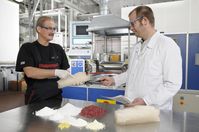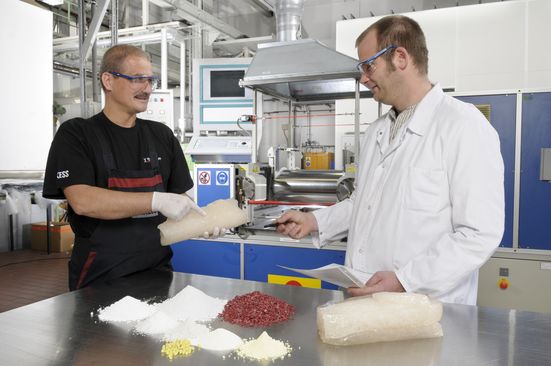Asia
EMEA

LANXESS Canada Contacts
Contact our Sites in Canada
Media Inquiries
General Inquiries
Please click here to e-mail LANXESS Canada with product inquiries and general requests.
Global Press Releases
2013-12-02
LANXESS Polymer Testing Center now with Innovation & Technology
No longer a secret science
The technological challenges rubber is faced with – in tires or toothed belts, for example – are growing all the time. As a result, complex rubber products for demanding tasks can scarcely be developed using “gut feeling” alone as they were in the past. For approximately 10 years now, the synthetic rubber pioneer LANXESS has therefore been offering the services of its Polymer Testing Center to external customers, too. LANXESS is now attaching increased importance to polymer analysis by integrating the Center, which was previously part of the High Performance Elastomers business unit, into its Innovation & Technology group function. This powerful organizational unit coordinates all of the LANXESS group’s research and development activities. The Leverkusen-based rubber experts there can offer more than the standard measuring of abrasion resistance, shore hardness, viscosity, tensile strength and fabric bonding. They also have sophisticated physical methods for assessing the molecular microstructure of the vulcanizates, which can provide crucial information for optimizing products. The complete current portfolio of the Polymer Testing Center has been brought together in a comprehensive brochure that can be downloaded at www.polymertesting.lanxess.com.
“Cutting-edge rubber formulations are extremely complex multi-component systems whose development requires a great deal of experience,” says Professor Claus Wrana, head of the LANXESS Polymer Testing Laboratory in Leverkusen, Germany. “Over the past few decades, polymer physics has developed a series of methods that enable us to explain the properties of rubber products by looking at the molecular structure of their components. As a major rubber supplier and developer with strong research credentials, LANXESS has played a big part in that. We not only use this expertise internally for the further development of our own rubbers, we are also happy to pass it on to the rest of the industry,” says Wrana. “In so doing, we not only provide measurements, we also explicitly see ourselves as problem solvers, helping to tackle challenges using polymer physics.”
The Polymer Testing Center is based in building K10 of the Chempark Leverkusen site – a building steeped in tradition. Its customers primarily include SMEs in the rubber industry that commission Professor Wrana’s team with manufacturing and examining material samples for them. The equipment in his laboratory is certainly extensive. It comprises a series of mixers for manufacturing test mixtures on a laboratory (85 ml) to technical (90 l) scale and molds and extruders for the compression molding of specimens. It is also possible to follow the vulcanization process using a moving die rheometer (MDR) or a rubber process analyzer (RPA). The most important rubber chemicals for manufacturing mixtures can also be found in the warehouse.
More complex methods provided by the Polymer Testing Laboratory include creating master curves for characterizing the dynamic behavior of a rubber sample – and that over a period of up to 20 decades. This enables valid statements to be made about the distribution of molecular mass, branching structure and crosslinking density of a polymer, for example. In Leverkusen, the latter can also be assessed by observing the non-linear stress-strain-behavior of the vulcanizates using state-of-the-art modeling processes. Using measurements of the amplitude dependence of the dynamic moduli of shear or elasticity, for instance, LANXESS physicists can also give assessments of the nature of filler-filler or filler-polymer interaction in the rubber, which correlates with the filler distribution in the mold, among other things.
Thanks to an advanced lab information management system, all of the preparation steps and measurements can be followed online. The close networking of the department’s global sites enables material samples manufactured in China, for example, to be examined in Leverkusen – and vice versa, wherever the resources are available. This ensures jobs are completed quickly. The LANXESS experts are also on hand to assist customers when it comes to evaluating and interpreting the results and help them with targeted further development based on current scientific findings. “We have worked hard in the industry to earn our reputation as rubber problem-solvers,” says Professor Wrana. “And we believe that, at LANXESS Innovation & Technology, we can contribute even more to improving the material still further. We welcome every new challenge!”
LANXESS is a leading specialty chemicals company with sales of EUR 9.1 billion in 2012 and roughly 17,500 employees in 31 countries. The company is currently represented at 52 production sites worldwide. The core business of LANXESS is the development, manufacturing and marketing of plastics, rubber, intermediates and specialty chemicals. LANXESS is a member of the leading sustainability indices Dow Jones Sustainability Index (DJSI) World and FTSE4Good as well as the Carbon Disclosure Leadership Index (CDLI).
- Gallery




